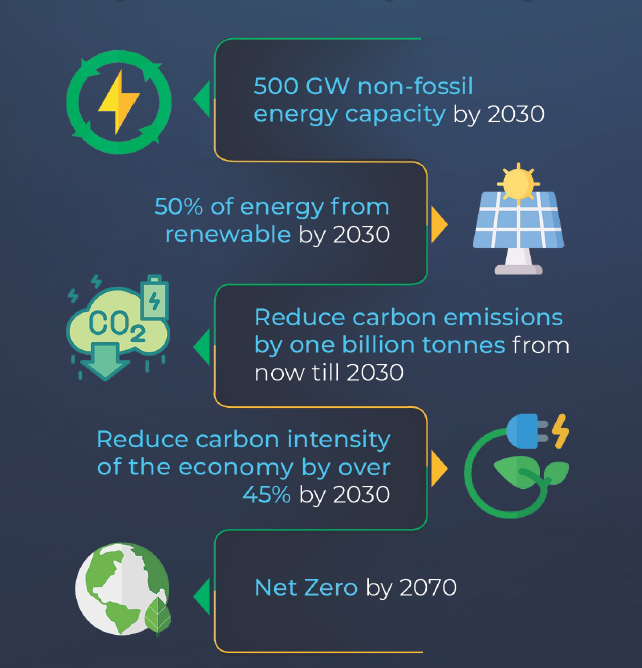India is embracing a greener and brighter future, proving to the global world that sustainability is an achievable goal. With an ethos of “One Earth, One Family, One Future,” in the G20 summit, India aims to balance its economic growth with the ecological conservation, crafting a blueprint for a sustainable future for the rest of the world to follow.
At the heart of India’s sustainability drive is the ambitious climate action plan that was announced at the UN Climate Change Conference (COP26) in the Glasgow by Prime Minister Narendra Modi. As part of this plan, he set the ambitious target of net-zero emissions by 2070 for India through his ‘Panchamrit’ – five-fold path: attaining a 500 GW renewable energy capacity, sourcing 50% energy from non-fossil fuels, reducing carbon emissions by one billion tonnes, decreasing the economy’s carbon intensity by 45% (all by 2030), and finally achieving net-zero emissions by 2070.

Furthermore, the visionary LiFE (Lifestyle for Environment) initiative introduced by Prime Minister Modi emphasizes the significance of adopting a lifestyle that prioritizes environmental consciousness, reaffirming India’s dedication to this cause. Through the organization of workshops, seminars, and the provision of online resources, LiFE empowers individuals with the essential knowledge to comprehend the interlinkage between their choices and the well-being of the environment.

The Green Budget
The nation’s budget is also helping to steer the course towards a greener future. The Government of India has put forth several measures in the FY 2023-2024 financial budget to champion the green cause. These include the Green Credit Programme under the Environment (Protection) Act, PM-Pranam for promoting alternative fertilisers, and the GOBARdhan scheme to generate wealth from waste. There are also efforts to enhance mangrove plantations, promote energy-efficient coastal shipping, and incentivize the adoption of electric vehicles.
In addition to this, the government has announced programmes for green fuel, energy, farming, mobility, buildings, and equipment, along with the policies for efficient energy use. The increased allocation of ₹10,222 crore for the renewable energy sector is a testament to India’s commitment towards green growth.
Leadership in Climate Action
India’s dedicated and forward-thinking initiatives aimed at tackling the pressing issue of climate change have been recognized and applauded on a global scale. This global acknowledgement signifies an increasing acceptance and respect for the country’s environmentally-conscious direction and exemplifies unwavering dedication to the protection and preservation of our planet.
At the heart of these commendable efforts is the International Solar Alliance (ISA), an international organization primarily led by India. The Alliance is guided by a shared objective of efficiently exploiting solar energy to reduce dependence on fossil fuels and make renewable energy a significant part of the energy mix. This is anticipated to be a key driver in mitigating climate change by reducing greenhouse gas emissions.
India’s renewable energy capacity increased by 126% between 2014 and 2021, propelled by initiatives like the International Solar Alliance and the world’s largest LED bulb distribution scheme, UJALA. In addition, India aims to establish Ladakh as a hub for solar power, with plans to develop an interstate power transmission system to facilitate the distribution of 13 GW of renewable energy generated in the region.
Environment Conservation
The Namami Gange project, a comprehensive endeavor launched by the Indian government to safeguard and rejuvenate the Ganga river, stands as a symbol of India’s commitment to environmental conservation. This ambitious initiative targets not only the cleanliness and ecological health of the river but also promotes biodiversity and sustainable development around the river basin. The objective is to ensure the Ganga, often referred to as India’s lifeline, regains its pristine status and remains a source of sustenance for generations to come.
As per the most recent reports, the Namami Gange project has accomplished a noteworthy milestone in its constant endeavor to preserve the river. With 183 out of 364 approved projects now operational, it reflects a substantial advancement towards fulfilling its long-term objectives. The operational projects encompass a wide range of areas, encompassing sewage treatment infrastructure, riverfront development, river-surface cleaning, biodiversity conservation, afforestation, public awareness campaigns, and monitoring of industrial effluents.

Innovations in Hydropower and Green Fuel
In the hydropower sector, a comprehensive framework has been proposed by the government specifically for pumped storage projects. These projects are a form of grid energy storage, where excess electricity is used to pump water uphill to a storage reservoir. The water is then released to generate electricity when the demand is high. This proposed framework signifies a concerted effort to harness India’s estimated 120 gigawatt (GW) potential across 120 sites, indicative of a sizable opportunity for sustainable energy generation.
Alongside this, the financial budget for the fiscal year 2023-2024 reflects the government’s continued commitment to a greener future. It includes a substantial allocation of ₹35,000 crore, specifically set aside for priority capital investments. The Ministry of Petroleum & Natural Gas, entrusted with these funds, will utilize them to meet India’s net-zero objectives. This allocation underscores the government’s determination to finance and fast-track renewable energy projects, thereby reducing the country’s reliance on fossil fuels.
This shift towards a greener future is not only confined to government initiatives. Major public sector undertakings in the energy sector, such as Indian Oil, Bharat Petroleum Corporation (BPCL), and Hindustan Petroleum (HPCL), have also announced their net-zero targets and are actively investing in and adopting green technologies, with a particular focus on hydrogen.
Hydrogen, as a clean, flexible, and abundant energy carrier, offers significant potential for hard-to-decarbonize sectors, such as industry and heavy-duty transport. By making strides towards this technology, these companies are demonstrating their commitment to reducing their carbon footprint and aligning their operations with India’s broader sustainability goals.
Nature and Wildlife Conservation
The sustainable journey is not only about clean energy or green industries but also involves preserving India’s rich biodiversity. The country has witnessed an increase in the population of tigers, Asiatic lions, one-horned rhinoceros, and leopards, indicating successful conservation efforts.
The expansion of protected areas by 32% has contributed to the growth of wildlife habitats, allowing the wild kingdom to flourish. The government’s conservation initiatives have yielded remarkable results, with a 33% increase in the tiger population from 2014 to 2018. Additionally, the population of Asiatic lions has seen a substantial rise of 64% between 2010 and 2020. Moreover, there has been a significant 62% increase in the leopard population from 2014 to 2018, and a notable 15% increase in the population of greater one-horned rhinoceros from 2014 to 2019.

As India progresses along this path, it underscores that sustainability and growth can go hand in hand. With a blend of visionary leadership, innovative policies, and people’s participation, India is truly becoming a beacon of green and sustainable development. This journey not only signifies the country’s commitment to its people and the environment but also its contribution towards the collective global fight against climate change.







